The BitFenix Formula Gold 650W PSU Review: Balanced
by E. Fylladitakis on June 13, 2018 8:00 AM EST- Posted in
- Cases/Cooling/PSUs
- PSUs
- 80Plus Gold
- bitfenix
- 650W
External Appearance
The 650W version of the BitFenix Formula Gold PSU is built inside an ATX-compliant chassis that is just 140 mm deep. Although none of the cables are modular, the designer tried to make the unit aesthetically unit via simple interventions. The fan cutout is rectangular instead of circular, with a finger guard to match. A round metallic badge with the company logo lays enclosed into the bars of the fan's guard, right above the engine. A satin black paint covers the chassis that is very well applied but also exceptionally prone to fingermarks. Decorative side stickers cover both the left and right side of the PSU. A large sticker with the electrical specifications and certifications of the PSU can be seen at the top side of the chassis.
The front and rear sides of the unit are textbook. A simple AC cable receptacle and an on/off switch can be seen at the perforated rear side of the PSU, with a large dead area below them that would normally be home to a company logo badge, but BitFenix decided to minimize visual interferences (and lower the manufacturing cost a bit). The front is entirely plain, with only a single opening where all of the cables are coming out from.
All of the unit's cables come out from a single port. The wires and connectors are all black, with flat, ribbon-like wires without any external covering for almost every cable. The only exception is the thick 24-pin ATX cable, which is made of simple wires that are enclosed into black nylon sleeving. A significant part of the 24-pin ATX cable is covered in heat shrink and appears to be curiously thick. That is because the heat shrink is hiding extra filtering capacitors for improved power quality, an approach that definitely helps but also makes the ATX cable very rigid and a nightmare during cable management.
Internal Design
Due to the standard 140 mm long chassis, the largest fan that can fit in the Formula Gold is an 120 mm one. The fan is supplied by MARTECH, a relatively reputable but not very popular Chinese manufacturer. Its part number is DF1202512SEMN and has a rifled sleeve bearing engine. Its maximum speed is about 2000 RPM, which is relatively high for a 120 mm fan and would make the PSU very loud if it were to work near its top speed.
A simple glance inside the Formula Gold reveals a familiar design. I am quite confident that the OEM behind the Formula Gold is Channel Well Technology (CWT), the same company behind the previous BitFenix Whisper M units. The platform of the Formula Gold is wholly different than that of the Whisper M, appearing to be yet another upgrade of the GPN platform that CWT first released many years ago, with many versions in between then and today.
The filtering stage of the Formula Gold begins at the rear of the AC receptacle, where we see two Y capacitors and one X capacitor. Two more Y capacitors and one more X capacitor, as well as two filtering inductors and a surge-suppressing MOV can be seen on the main PCB, summing up to a textbook filtering stage. The large heatsink across the right side of the unit holds the single bridge rectifier, the active components of the APFC stage, and the two MOSFETs of the primary inversion circuit. The APFC stage capacitor is supplied by RubyCon and is rated at 400V/680μF.
The primary inversion circuit is relatively simple, with two MOSFETs forming a half-bridge topology that is supported by an LLC resonant converter. The MOSFETs of the secondary side are on the underside of the PCB, with thin and tall heatsinks attached directly on the main PCB to provide cooling for them. The secondary conversion circuit generates only the 12V line, the 3.3V/5V lines are being derived via tertiary DC-to-DC converters. The secondary side electrolytic capacitors are all supplied by Nippon Chemi-Con, while the polymer capacitors inside the PSU are supplied by Nichicon. The capacitors in the ATX cable are supplied by Nippon Chemi-Con. All of the capacitors of the Formula Gold are supplied by Japanese manufacturers, just like BitFenix says they are.



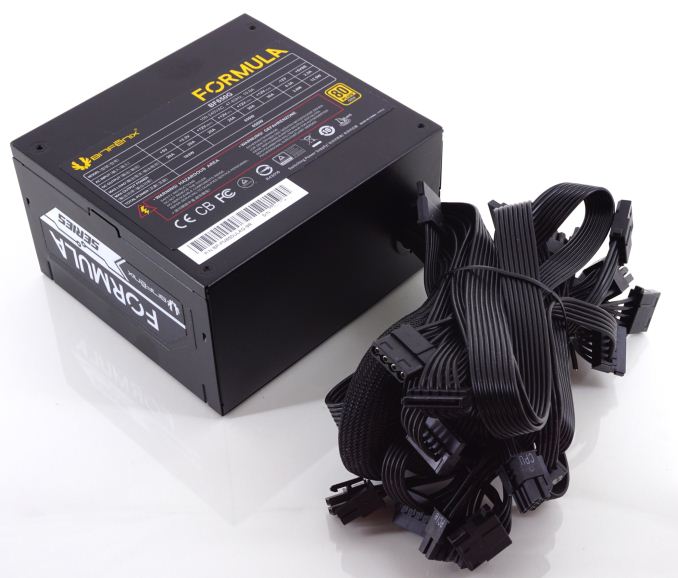
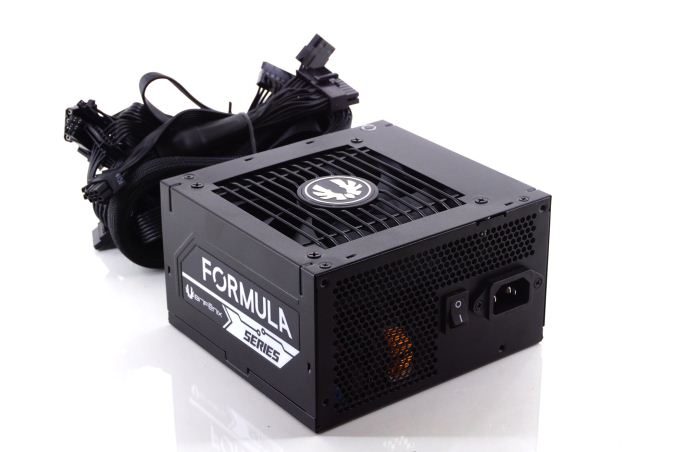
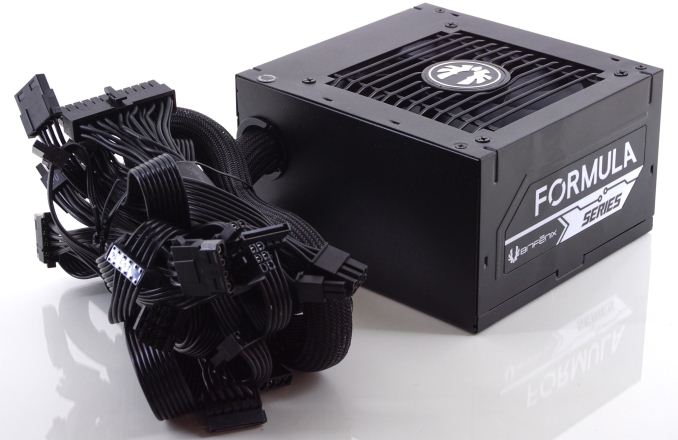

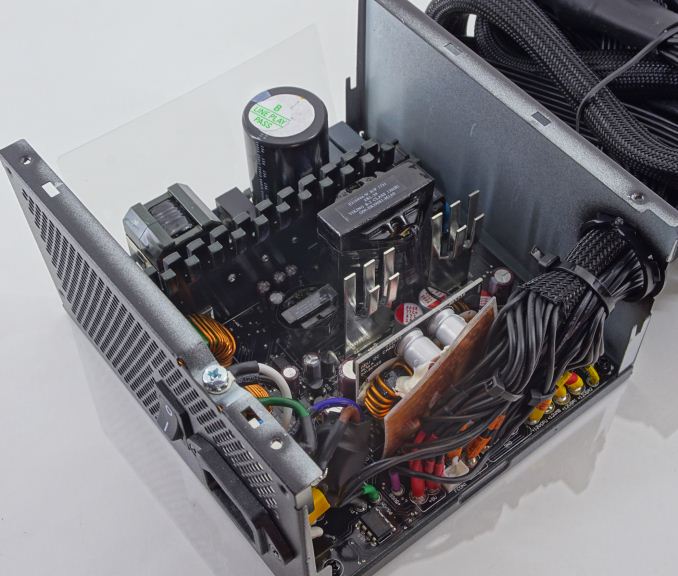
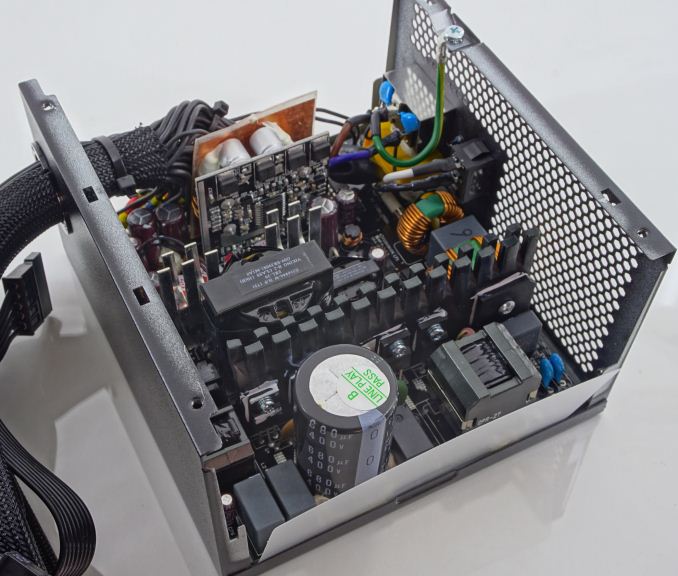

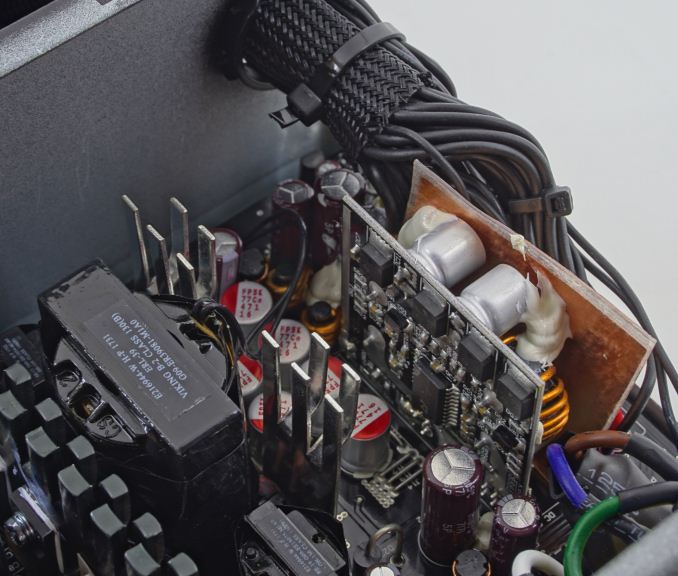








12 Comments
View All Comments
DanNeely - Wednesday, June 13, 2018 - link
"Modern power supplies work on both systems, however the nature of switching means that they are slightly more efficient with higher voltage inputs. "Is there something specific to switch mode design that makes lower voltage hurt? I'd always assumed it the difference was due to the 4x higher I^2*R resistive losses on the input end.
E.Fyll - Thursday, June 14, 2018 - link
That is generally correct. Actually, a lower input voltage will decrease the switching-related frequency losses as well (the switching cycle is longer to maintain the same energy output). That's why this PSU displayed almost identical efficiency at lower loads regardless of the input voltage -the resistive losses are higher with a 115V input but the switching losses at low loads are lower, so they virtually negate each other. At higher loads however, the switching losses are minimized regardless of the input voltage, whereas the resistive losses are (theoretically) always four times higher. They actually tend to be even higher than that, because higher component temperatures increase the resistive losses, and the higher resistive losses increase the component temperatures even further. It's a vicious circle.benedict - Wednesday, June 13, 2018 - link
Sell it for 60-65$ and it will be a hit. At 80$ it's just one of many.Orange14 - Wednesday, June 13, 2018 - link
For $10 more I could purchase an equivalent wattage Seasonic that is fully modular and has a 10 year warranty, At this price point, there is no compelling reason for this PSU to exist.AdrianB1 - Wednesday, June 13, 2018 - link
You are totally right. For this price it should be at least semi-modular and have better features, like passive mode and/or higher efficiency.qlum - Thursday, June 14, 2018 - link
I personally prefer non modular over modular as I prefer not ot use a shroud and non modular just looks better on the front of the case. Tje few extra cables I can easily hide on the back anyway.AdrianB1 - Thursday, June 14, 2018 - link
Semi-modular is the best of the 2 worlds, you have the ATX 24 pin cable built in like in a non-modular PSU and the other cables are connected only if you need them, so you don't have to hide anything on the back, leave it in a drawer.Death666Angel - Friday, June 15, 2018 - link
I don't follow. How do you see your PSU from the front of your case? What kind of shroud do you use with your PSU and why are more cables better in that case? Do you use some very specific cases?My last non (semi) modular PSU was a Silverstone one I used in a Lian Li mATX box (V351b) with a few short cables that fit my need. At that point, modular was still a good bit more expensive. After that though, I had at least semi-modular or fully modular PSU and like the ease of use of installing them, as well as the less clutter. But I also use mATX or smaller cases.
boozed - Wednesday, June 13, 2018 - link
Not to be confused with Bitfinex.I did once see the Bitfenix logo used by accident at a fraudcoin conference.
crashtech - Saturday, June 16, 2018 - link
At this very moment, the SeaSonic SSR-650RM is a few dollars less, so there's no reason to buy this PSU, which ought to be in the $65to be at all interesting.